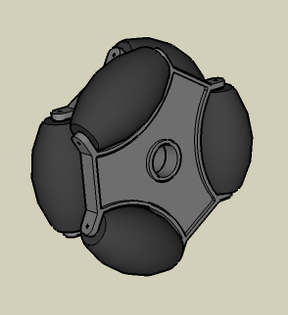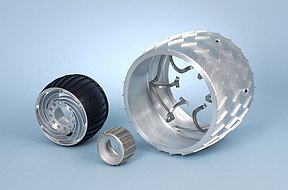Robotics/Types of Robots/Wheeled
Wheeled robots are robots that navigate around the ground using motorized wheels to propel themselves. This design is simpler than using treads or legs and by using wheels they are easier to design, build, and program for movement in flat, not-so-rugged terrain. They are also more well controlled than other types of robots. Disadvantages of wheeled robots are that they can not navigate well over obstacles, such as rocky terrain, sharp declines, or areas with low friction. Wheeled robots are most popular among the consumer market, their differential steering provides low cost and simplicity. Robots can have any number of wheels, but three wheels are sufficient for static and dynamic balance. Additional wheels can add to balance; however, additional mechanisms will be required to keep all the wheels in the ground, when the terrain is not flat.
Navigation
[edit | edit source]Most wheeled robots use differential steering, which uses separately driven wheels for movement. They can change direction by rotating each wheel at a different speed. There may be additional wheels that are not driven by a motor these extra wheels help keep it balanced.
2-wheeled robots
[edit | edit source]Two wheeled robots are harder to balance than other types because they must keeping moving to maintain upright. The center of gravity of the robot body is kept below the axle, usually this is accomplished by mounting the batteries below the body. They can have their wheels parallel to each other, these vehicles are called dicycles, or one wheel in front of the other, tandemly placed wheels. Two wheeled robots must keep moving to remain upright and they can do this by driving in the direction the robot is falling. To balance, the base of the robot must stay with under its center of gravity. For a robot that has the left and right wheels, it needs at least two sensors. A tilt sensor that is used to determine tilt angle and wheel encoders which keep track of the position of the platform of the robot.

Examples
[edit | edit source]Roomba
[edit | edit source]Roombas are two-wheeled vacuum cleaners that automatically moves around cleaning up a room. They utilizes a contact sensor in the front and a infrared sensor on its top.

Segway
[edit | edit source]Segways are self-balancing dicycle electric vehicles.
Ghost Rider
[edit | edit source]Ghost Rider was the only two wheeled robot entered for the Darpa Grand 2005 Challenge. It was unique because of its motorcycle design, unlike the other two-wheeled robots, the wheel alignment is front and back, which makes it harder to balance as it turns. This tandem design of the wheels is much less common than that of a dicycle.
3-wheeled vehicles
[edit | edit source]3-wheeled robots may be of two types: differentially steered (2 powered wheels with an additional free rotating wheel to keep the body in balance) or 2 wheels powered by a single source and a powered steering for the third wheel. In the case of differentially steered wheels, the robot direction may be changed by varying the relative rate of rotation of the two separately driven wheels. If both the wheels are driven in the same direction and speed, the robot will go straight. Otherwise, depending on the speed of rotation and its direction, the center of rotation may fall anywhere in the line joining the two wheels.

The center of gravity in this type of robot has to lay inside the triangle formed by the wheels. If too heavy of a mass is mounted to the side of the free rotating wheel, the robot will tip over.
Omni Wheels
[edit | edit source]Another option for wheeled robots that makes it easier for robots with wheels not all mounted on the same axis to have Omni Wheels. An omni wheel is like many smaller wheels making up a large one, the smaller ones have axis perpendicular to the axis of the core wheel. This allows the wheels to move in two directions, and the ability to move holonomically, which means it can instantaneously move in any direction. Unlike a car, which moves non-holnomicallly and has to be in motion to change heading. Omni-wheeled robots can move in at any angle in any direction, without rotating beforehand. Some omni wheel robots use a triangular platform, with the three wheels spaced at 60 degree angles. Advantages of using 3 wheels and not 4 are that its cheaper, and 3 points are guaranteed to be on the same plane, so each wheel in contact with the ground, but only one wheel will be rotating in the direction of travel. The disadvantages of using Omni wheels is that they have poor efficiency due to not all the wheels rotating in the direction of movement, which also causes loss from friction, and are more computationally complex because of the angle calculations of movement.

4-wheeled vehicles
[edit | edit source]2 powered, 2 free rotating wheels
[edit | edit source]Same as the Differentially steered ones above but with 2 free rotating wheels for extra balance.

More stable than the three wheel version since the center of gravity has to remain inside the rectangle formed by the four wheels instead of a triangle. This leaves a larger useful space. Still it's advisable to keep the center of gravity to the middle of the rectangle as this is the most stable configuration, especially when taking sharp turns or moving over a non-level surface.
2-by-2 powered wheels for tank-like movement
[edit | edit source]

This kind of robot uses 2 pairs of powered wheels. Each pair (connected by a line) turn in the same direction. The tricky part of this kind of propulsion is getting all the wheels to turn with the same speed. If the wheels in a pair aren't running with the same speed, the slower one will slip (inefficient). If the pairs don't run at the same speed the robot won't be able to drive straight. A good design will have to incorporate some form of car-like steering.
Car-like steering
[edit | edit source]
This method allows the robot to turn in the same way a car does. This is a far harder method to build and makes dead reckoning much harder as well. This system does have an advantage over previous methods when your robot is powered by a combustion engine: It only needs one motor (and a servo for steering of course). The previous methods would require either 2 motors or a very complicated gearbox, since they require 2 output axles with independent speed and direction of rotation.
Examples
[edit | edit source]The DARPA Grand and Urban Challenges pit robotic cars against one another in a series of navigational tests. These robots are fully automated and drive themselves along the test course. The DOD sponsors the competition and it is used to facilitate robotic development.
5 or more wheeled vehicles
[edit | edit source]For larger robots. Not always very practical.
Especially when more powered wheels are used the design becomes much more complex as each of the wheels have to turn with the same speed when the robot has to move forwards. Differences in speed between the left and right wheels in differentially steered robots cause the robot to move to the side instead of in a straight line. Difference in speed between wheel on the same side cause slipping of the slowest wheel.
Sometimes an extra free rotating wheel with odometry is added to the robot. This measures more accurately how the robot moves. Odometry on the powered wheels excludes slip and other movements and thus could be erroneous.
Examples
[edit | edit source]The Mars Rovers (Sojourner, Spirit, Opportunity) are six wheeled robots that navigate across Martian terrain after landing. They are used to examine territory, interesting landmarks and make observations about the surface of Mars. They have a suspension system which keeps all six wheels in contact with the surface, and helps them traverse slopes ans sandy terrain.



One Wheel
[edit | edit source]One wheeled robots are extremely difficult to keep balanced due to the single point of contact with the ground. There have been experimental designs and robots that do only have one wheel. It is easier to use a spherical wheel rather than a typical disc wheel, as the robot can move in any direction along the sphere. An example sketch shows the basic idea of using gyroscopes and counter-torque mechanisms to keep the robot upright. The spinning flywheels stabilize and tilt it, allowing for non-holonomic movement.
